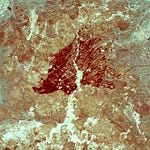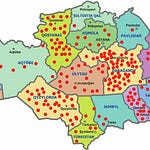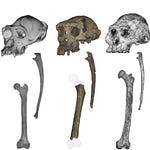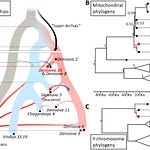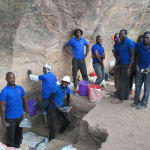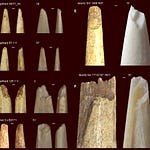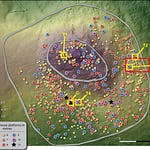In the dry highlands of southern Peru, long before the rise of empires and elites, people built monuments to the dead. They didn’t do so with armies of laborers or kings commanding divine authority. Instead, they used memory, ceremony, and the slow accumulation of ritual acts.
At Kaillachuro, a modest ridge in the Lake Titicaca Basin, archaeologists have excavated1 a cluster of low burial mounds dating back over 5,000 years. What they found rewrites the story of monumental architecture in the Andes—and perhaps elsewhere.
“These mounds weren’t the product of hierarchical power or centralized planning,” said Luis Flores-Blanco, lead author of the new study published in Antiquity. “They’re the outcome of generations of funerals, offerings, and community remembrance.”
Rethinking Monumentality
For decades, archaeologists have associated monumental architecture with state formation: the emergence of stratified societies with ruling classes, surplus labor, and coercive force. Pyramids, palaces, and temples were thought to require elites to coordinate large-scale projects. But that model is starting to fray.
Recent discoveries around the world suggest that egalitarian communities—some still organized as mobile foragers—also built large, symbolically charged structures. Göbekli Tepe in Turkey, for example, was built by hunter-gatherers 11,000 years ago. The Andean record, long studied for its massive temple complexes and ancient cities, is now revealing its own early forms of collective monumentality.

Kaillachuro pushes the timeline back in the Titicaca Basin by 1,500 years. Located at 3,930 meters above sea level, the site contains nine earthen mounds, many built atop human burials. Over multiple excavation seasons, researchers uncovered more than 76,000 artifacts, including projectile points, beads, ceramic fragments, ochre, and burned animal remains. The earliest mound layers date to around 5300 years ago; construction continued intermittently for two millennia.
A Monument Made of Memory
The story that emerges from the stratigraphy is one of ritual repetition. Burial pits, often modest—some containing little more than a single femur—were placed in prepared clay floors. Bodies were interred with beads, stone tools, or red ochre, a pigment often used in funerary rites. Fires were lit, perhaps for feasting or purification.
“The mounds grew gradually, like sedimentary memories,” said co-author Mark Aldenderfer. “Each layer reflects not just a burial, but a return to the place—to commemorate, to grieve, to reaffirm connection.”
Some burials were placed in stone-lined cists or boxes, particularly in later phases. One child’s skeleton, dated to about 3,400 years ago, was found in a plastered tomb covered in red ochre and obsidian flakes. In other mounds, researchers discovered enclosures with thick stone walls, platforms, and hearths filled with camelid and bird bones.
But these were not elite tombs. The absence of elaborate grave goods or conspicuous wealth suggests these were not rulers. Instead, these were likely community members, perhaps revered ancestors. Their interment gradually reshaped the landscape.
Ritual First, Power Later?
Kaillachuro complicates assumptions about the relationship between ritual and hierarchy. The idea that monuments follow social stratification—a top-down imposition of power—doesn’t hold here. Instead, it appears that the mounds preceded social complexity. They may have enabled it.
“The implication is that ritual itself—not surplus, not inequality—may have been the driving force behind the emergence of large-scale architecture,” said Flores-Blanco.
This interpretation echoes broader debates in archaeology about the role of communal memory, shared symbolic practice, and the dead in binding early societies. In the Andes, where ancestor veneration often shapes both landscape and political legitimacy, these early mounds hint at the roots of that cultural logic.
“What we’re seeing is the deep past of Andean ways of relating to the dead,” said Aldenderfer. “Before statecraft, before agriculture was fully adopted—there was memory, and place, and ceremony.”
Small Scale, Big Questions
The mounds at Kaillachuro are not massive. Most reach no more than 1.5 meters in height. But size isn’t the point. What matters is the endurance and repetition. The fact that people returned to these mounds over generations—and that the site was reused during the Inca period centuries later—suggests enduring significance.
This continuity also raises new questions. How did burial and ritual help catalyze more complex forms of social organization? Did mound-building foster territorial claims? Did repeated ceremony cultivate shared identity or ritual specialists?
Kaillachuro doesn’t offer definitive answers, but it shows that monumental architecture—however modest—was not born of kings. Sometimes, it began with the dead.
Related Research
Here are several studies related to early monumental architecture, Andean prehistory, and mortuary practices:
Núñez, L., & Perlès, C. (2018). Tulán-52: A Late Archaic ceremonial centre at the dawn of the Neolithisation process in the Atacama Desert. Antiquity, 92(366), 1231–1246. https://doi.org/10.15184/aqy.2018.195
Cohen, A. (2010). Ritual and architecture in the Titicaca Basin: The development of the sunken court complex in the Formative Period (Doctoral dissertation, UCLA). [Available via ProQuest or university libraries]
Hastorf, C. A. (2003). Community with the ancestors: ceremonies and social memory in the Middle Formative at Chiripa, Bolivia. Journal of Anthropological Archaeology, 22(4), 305–332. https://doi.org/10.1016/S0278-4165(03)00029-1
Aldenderfer, M. (2004). Preludes to power in the highland Late Preceramic period. Archaeological Papers of the American Anthropological Association, 14(1), 13–35. https://doi.org/10.1525/ap3a.2004.14.013
Power, X. et al. (2022). Ritual stone-built architecture and shell midden foundation: A semisubterranean structure in the hyperarid Atacama Desert coast, Northern Chile. Geoarchaeology, 37(2), 198–226. https://doi.org/10.1002/gea.21857
Flores-Blanco, L., & Aldenderfer, M. (2025). Kaillachuro: early monumental architecture of the Titicaca Basin, 5300–3000 BP. Antiquity, 99(405), 689–707. https://doi.org/10.15184/aqy.2025.40


